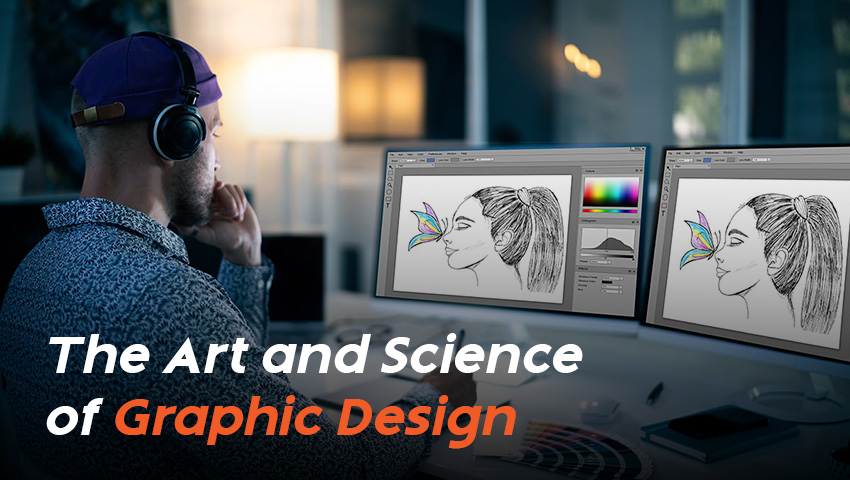
In the digital age, where attention spans are short, and competition for engagement is fierce, graphic design has become more important than ever. From brand logos to website layouts, from advertisements to social media posts—graphic design shapes the way we communicate visually. But what exactly is graphic design, and why is it crucial for businesses, brands, and content creators?
Graphic design is the art and practice of creating visual content to communicate messages. Designers use typography, imagery, color, and layout to craft eye-catching designs that convey meaning and evoke emotion. Whether it’s a billboard ad, a website banner, or a product label, graphic design is all about merging creativity with strategy to deliver a message effectively.
Graphic design is more than just creating beautiful visuals—it’s about using design principles to enhance communication. Here are the key elements that every graphic designer works with:
Typography: This is the art of arranging type to make written language legible, readable, and visually appealing. Font selection, size, spacing, and alignment all play a role in delivering a message.
Color: Colors can convey emotions and create mood. Designers choose color schemes that align with the message they want to send. For example, blue often evokes trust, while red can stimulate passion or urgency.
Images and Graphics: Designers incorporate photos, illustrations, or other visual elements to create a more engaging design. High-quality visuals are key to capturing attention and complementing the overall aesthetic.
Layout: The arrangement of elements on a page or screen is critical to how effectively a design communicates. A well-thought-out layout directs the viewer’s eye in a natural way, ensuring the most important information is highlighted.
Space: Often referred to as "negative space" or "white space," the use of empty areas within a design allows content to breathe and prevents the layout from feeling cluttered. Space can be just as important as the elements themselves.
Graphic design plays a vital role in business branding, marketing, and customer experience. Here’s why it matters:
First Impressions Matter: When potential customers encounter your brand for the first time—whether through a website, ad, or social media post—they form opinions within seconds. Professional and engaging design creates a positive first impression, building trust and interest.
Brand Identity: Consistency in graphic design is crucial for creating a memorable brand. Everything from your logo to your website layout communicates your brand’s values and voice. Strong design helps reinforce your brand identity and differentiate it from competitors.
Enhanced Communication: A well-designed visual can convey a message more powerfully than words alone. Whether it’s an infographic explaining complex data or a poster promoting an event, graphic design makes communication more efficient and engaging.
Boosts Conversions: Effective design doesn’t just look good; it also drives action. Whether it’s a website call-to-action button, a product packaging design, or a sales ad, good design can influence consumer behavior, leading to higher conversions and sales.
Supports Digital Marketing: From social media content to email marketing campaigns, businesses rely on visually appealing graphics to capture attention and drive engagement. In today’s online world, where visuals dominate, a lack of professional design can lead to missed opportunities.
Graphic design covers a wide range of applications. Here are some of the most common types:
Branding and Identity: This involves creating logos, business cards, packaging, and other branding materials that define the visual identity of a business.
Web Design: Designing user-friendly and aesthetically pleasing websites that enhance user experience while reflecting a brand’s personality.
Advertising Design: From print ads to digital banners, advertising design focuses on creating compelling visuals to attract and persuade customers.
Motion Graphics: Animated graphics used in video production, from explainer videos to website animations, are part of this growing category.
Print Design: Brochures, magazines, posters, and product packaging fall into the print design category, where layout, typography, and imagery are key.
In the current digital landscape, graphic designers are more than just artists—they’re problem solvers. Their role extends beyond creating aesthetically pleasing visuals to understanding user experience, branding strategy, and content marketing. As the demand for digital content continues to grow, so does the need for skilled graphic designers who can create across various platforms and formats.
User-Centered Design: Graphic designers are increasingly involved in user interface (UI) and user experience (UX) design, ensuring that digital products like websites and apps are not only visually appealing but also easy to navigate.
Collaborators in Marketing: Graphic designers work closely with marketing teams to create visuals that align with campaign goals, target audiences, and key messaging. This collaboration ensures that designs are both functional and strategic.
Keeping Up with Trends: As design trends evolve, graphic designers must stay updated on new technologies, design techniques, and consumer preferences. This allows them to create relevant, innovative, and engaging designs.
As technology continues to evolve, so too does the field of graphic design. Emerging technologies such as augmented reality (AR), virtual reality (VR), and artificial intelligence (AI) are creating new possibilities for designers. Brands are beginning to explore interactive designs that blend the physical and digital worlds, opening new doors for customer engagement.
Additionally, the rise of social media and mobile platforms means that design is no longer static—it’s dynamic and responsive. The future of graphic design will likely focus on creating immersive, interactive experiences that captivate audiences in fresh and innovative ways.
Graphic design is a powerful tool that can transform how a brand communicates with its audience. It blends creativity with strategy, art with communication, and aesthetics with functionality. Whether you’re a business looking to stand out or a designer honing your craft, understanding the importance and impact of graphic design is essential in today’s visually-driven world.
Ready to make your visual mark? Contact us for your graphic design needs and inquiries.
Design is thinking made visual -Saul Bass